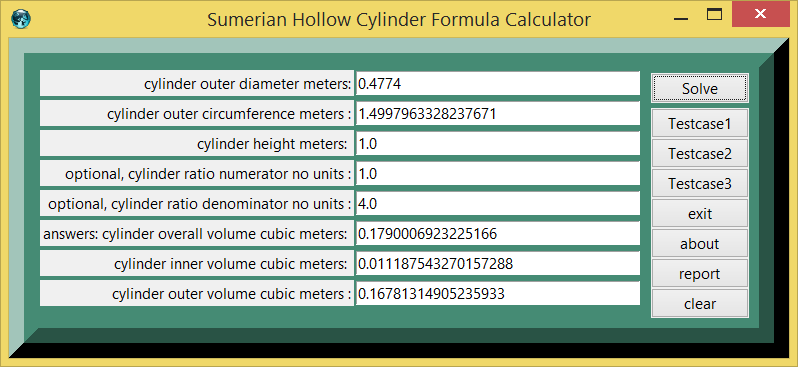Version 2 of Sumerian Surveyor Area Formula and eTCL Slot Calculator Demo Example, numerical analysis
Updated 2016-05-20 18:32:27 by goldSumerian Surveyor Area Formula and eTCL Slot Calculator Demo Example, numerical analysis
This page is under development. Comments are welcome, but please load any comments in the comments section at the bottom of the page. Please include your wiki MONIKER in your comment with the same courtesy that I will give you. Its very hard to reply intelligibly without some background of the correspondent. Thanks,gold
- Sumerian Surveyor Area Formula and eTCL Slot Calculator Demo Example, numerical analysis
- Appendix Code
- Comments Section
gold Here is some eTCL starter code for calculating the volume of a hollow cylinder. Most of the testcases involve replicas or models, using assumptions and rules of thumb.
Pseudocode and Equations
set volume_bowl [eval expr (5./60.)*(5./60.)*(4.*60.+48.) ] # 2 sila in Babylonian calculation
set conventional_vol? [eval expr 2.*((.5*.5/(3.*4.))*.09) ] # 0.00375 liters per m*m
set conv_circle [eval expr 1.5*1.5*(1/12.) ] # text answer 11/60+15/3600, decimal 0.1875
set strange_formula [eval expr $area*$area*(4.*60.+48.)] # possible sila per kus*kus factor
45 carrying baskets (45*25=1125kg) per 1us (360 meters) per workday
1_15 talents dirt (1_15=1/60+15/3600=37.5 kg) for 1 dana (1 dana=beru=10.8 km) per workday
6 bricks (b=8.5 minas>>6*8.5*0.4977kg,25.3827) for beru 10.8 kilometers per day
large basket (dusu) =2_13_20 volume shekel=1/27 volume shekel=13.33 kilograms=11.1 liters
small basket = 1_4 volume shekel=1/48 volume shekel=7.5 kilograms=6.25 liters
1 volume shekel = 300 liters = 12 talents =12*30=360 kilograms
1 talent =12 volume shekels Pseudocode and Equations
# following statements can be pasted successively into eTCL console
proc pi {} {expr acos(-1)}
set inner_cylinder_a=b*(c*c/d*d)_ [* 0.1790[/ [* 1. 1. ] [* 4. 4. ] ]] # 0.0111
set hollow_cylinder_a=b*(c*c/d*d)_ [* 0.1790[- 1. [/ [* 1. 1. ] [* 4. 4. ]] ]] # 0.1678
set inner_cylinder_ [ eval expr [pi]*.0597*.0597*1 ] # 0.0111
set outer_cylinder_ [ eval expr [pi]*.2387*.2387*1 ] # 0.1790
set overshoot_error [eval expr (2.5424/2.40909)-1. ] # 0.05533624729669717
set error_log_coefficient [eval expr (1.-3.125/[pi])*100.] # undershoot 0.52 percent error
set error_3_for_PI_coefficient [eval expr (1.-3.0/[pi])*100.] # undershoot 4.5 percent error
set log_coefficient_reciprocal [ eval expr (1./4.*[pi]) ] # 0.7853981633974483
set imla_reciprocal_PI_coefficient [ eval expr (1./6.*[pi]) ] # 0.5235987755982988
Testcases Section
In planning any software, it is advisable to gather a number of testcases to check the results of the program. The math for the testcases can be checked by pasting statements in the TCL console. Aside from the TCL calculator display, when one presses the report button on the calculator, one will have console show access to the capacity functions (subroutines).
Testcase 1
Testcase 2
Testcase 3
Screenshots Section
figure 1.
References:
- Eleanor Robson, Mesopotamian Mathematics, 2100-1600 BC (Oxford, 1999)
- Robson, Eleanor, Mesopotamian Mathematics, 2100-1600BCE,Oxford 1999
- Horowitz, Wayne, Late Babylonian Tablet CBS1766, Hebrew University
- Steele, J.M. Celestial Measurement in Bablylonian Astronomy,Annals of Science,2007
- Mathematical Cuneiform Texts, Neugebauer and A. Sachs, American Oriental Society, 1945
- Friberg 1987-90:555,Firberg on tablet BM15285
- Eclipse Prediction and the Length of the Saros in
- Babylonian Astronomy LIS BRACK-BERNSEN∗AND JOHN M. STEELE
- Celestial Measurement in Babylonian Astronomy, J. M. STEELE, University of Durham
- Amazing Traces of a Babylonian Origin in Greek Mathematics, Jöran Friberg and Joachim Marzahn
- The area and the side i added: some old Babylonian geometry, duncan j. Melville
- Sumerian Circular Segment Coefficients and Calculator Demo Example
- Sumerian Coefficients in the Pottery Factory and Calculator Demo Example
- Sumerian Pottery Vessel & Clay Mass and eTCL Slot Calculator Demo Example , numerical analysis
- Mathematics hidden behind the two coefficients of Babylonian geometry, kazuo muroi
- Especially oven/kiln problem in YBC7997, area of ring annulus complements bullseye figure.
- Sumerian Barge & Cargo Calculator and eTCL Slot Calculator Demo Example, numerical analysis
- Sumerian Coefficients at the Weavers Factory and eTCL Slot Calculator Demo Example
- Sumerian Construction Rates and eTCL Slot Calculator Demo Example
- Sumerian Workcrew & Payroll and eTCL Slot Calculator Demo Example, numerical analysis
- The design of Babylonian waterclocks : Astronomical and experimental evidence,Steele
Appendix Code
appendix TCL programs and scripts
Pushbutton Operation
For the push buttons, the recommended procedure is push testcase and fill frame, change first three entries etc, push solve, and then push report. Report allows copy and paste from console.
For testcases in a computer session, the eTCL calculator increments a new testcase number internally, eg. TC(1), TC(2) , TC(3) , TC(N). The testcase number is internal to the calculator and will not be printed until the report button is pushed for the current result numbers. The current result numbers will be cleared on the next solve button. The command { calculate; reportx } or { calculate ; reportx; clearx } can be added or changed to report automatically. Another wrinkle would be to print out the current text, delimiters, and numbers in a TCL wiki style table as
puts " %| testcase $testcase_number | value| units |comment |%" puts " &| volume| $volume| cubic meters |based on length $side1 and width $side2 |&"
gold This page is copyrighted under the TCL/TK license terms, this license .
Comments Section
Please place any comments here, Thanks.
